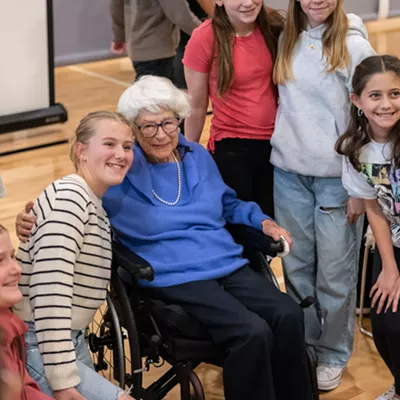The Life Above
[
{
"name": "Broadstreet - Instory",
"component": "25846487",
"insertPoint": "4",
"requiredCountToDisplay": "4"
},{
"name": "Broadstreet - Empower Local",
"component": "27852456",
"insertPoint": "8",
"requiredCountToDisplay": "8"
},{
"name": "Broadstreet - Instory",
"component": "25846487",
"insertPoint": "12",
"requiredCountToDisplay": "12"
},{
"name": "Broadstreet - Instory - 728x90 / 970x250",
"component": "27852677",
"insertPoint": "18",
"requiredCountToDisplay": "18"
},{
"name": "Broadstreet - Instory",
"component": "25846487",
"insertPoint": "5th",
"startingPoint": "23",
"requiredCountToDisplay": "24",
"maxInsertions": 100
}
]
by Marty Demarest & r & The world-famous underwear of Leona Dare is carefully preserved between sheets of acid-free tissue paper in a box stored in the underground archives of the Northwest Museum of Arts & amp; Culture in Spokane. There, in the museum's dark vaults, past corridors lined with paintings, sculptures and Native American artifacts, one of the museum's curators, Patti Larkin, lifts the underwear from its resting place with white cotton-gloved fingertips. More than a century after Dare wore them, her underpants hang in the humidity-controlled air.
If you don't know who Leona Dare was, suspend your questions for a moment. Focus instead -- as thousands of people before you have done -- on official museum catalogue number 2790.5, "Shorts, costume." They are made from a light blue sateen fabric that has stiffened with age and faded to sea foam green. Wide goldenrod stripes are stitched with fraying thread from top to bottom. Along each seam and thigh hole, sequences of tarnished sequins reflect an occasional, tawdry snatch of light.
At the height of their fame, however, these panties hovered thousands of feet in the air above the glowing faces of admirers in Europe, Asia and the Americas. The sequins, flashing their undimmed glory in spotlights and sunshine, caught the eyes of idle families and gentlemen seeking a thrill. Throughout the late 1800s, this underwear presented the world below with Leona Dare, internationally renowned trapeze artist, hanging by her teeth from a hot air balloon.
Beneath Dare's clenched jaw hung five and a half feet of woman encased in a blue bodice (official museum catalog number 2790.1) that displayed a generous cleft of generous cleavage. A midriff's worth of corset ribbing and 14 metal fasteners converged to forge a 27-inch waist. Dare's legs, poking through the sparkling circles in the panties, could support her own weight and that of a partner. The stripes on the shorts cupped down and around two round, athletic buttocks. Dare was a vigorous and voluptuous lady who, when lifted up, opened into one of the era's most popular spectacles. Her neck became a stem from which ankles, arms and thighs blossomed out of sky-blue satin like the stigmas of a dangling flower.
Metaphors for feminine anatomy are unavoidable in accounts of Dare. Newspaper reports are often lost in dazzling attempts to cover with vocabulary what Dare left exposed to contemplation. In the words of one of the papers of the era, she was "one of the shapeliest women whose hidden charms were ever revealed to the vulgar gaze of mortal man." We are told that "to view her as a woman would be to look at her stupidly, for the woman gives place to a vision, sliding on a beam of divine light, leaving us ecstatic in the contemplation of the beautiful. Hail! O prodigy, thou surpasseth the impetuous eagle." One Rio de Janeiro reporter simply left behind the observation that "Leona Dare is more than a woman; she is an ideality."
Dare first emerged in Chicago as an attractive, brave trapeze artist. Then nicknames began to accumulate: "Leona Dare, Queen of the Antilles" and "The Comet of 1873." The addition of a mouthpiece with a hook from which Leona could swing partners transformed her into a diva of the three-ring riots that rolled through every city in America. She was a headline act in one of the liveliest theatrical endeavors of the era, and started touring internationally, first with circuses, and then independently. In Russia, Dare and her husband conceived of the hot-air balloon ascension, and she became a star. After dazzling the crowd with her form and finesse, Dare would rise above the late 19th-century cityscapes with their crowded, dirty streets and float away.
The image of Dare afloat drifted into the public's consciousness, and she made a small part of herself into an indestructible piece of history. She dotted the ever-widening skylines of the industrial revolution. She adorned Berlin, London, Paris and Moscow, gracing stages, filling tents and generating gossip. She was "Oriental," "Spanish" and occasionally even (correctly) "American." She was mysterious, charming and, eventually, wealthy. In a world where fame spread at the speed of train engine and steamship, Leona Dare became a global success.
She still appears, occasionally, as she was then, and as others imagined her to be. In bins of cheaply printed "vintage" posters offered by discount department stores, it is possible to find a famous print by the artist Jules Cheret, which depicts Leona, this time in pink, beneath a balloon, passengers and an American flag. Beyond the clouds floats another balloon. In the distance, another lady swings across the horizon. We see them as the gentlemen riding in the balloons see them: we are adrift in a stormy skyscape hung with Leonas.
* * *
Let us leave Leona Dare suspended at the apex of her career for a few more happy moments. While the world wobbled below, Dare led the life above. We can find her in London during the autumn of 1888. She is illuminated with gaslight, swinging from a theater's ceiling. A short walk and a few street corners away, some other young women -- hopeful but hopeless prostitutes -- are being sliced open. The next day, Dare will share headlines (her act described as "obscene") with Jack the Ripper. A few years later, she hangs, untouchable, on the main stage of the Folies Bergere. Beneath her slippered toes buzzes an audience of well-dressed Parisians, and a background of anonymous women, each of whom survive by offering drinks, dances and touches.
Night after night, and any matinee that paid, Leona Dare rose, against all odds, above the dirty and uneasy life below. She left behind her murky past as a Civil War orphan, rejected the role that society offered her, eluded the gears of grinding poverty, stepped onto the stages of the pleasure palaces of the world, took her position beneath a waiting balloon, entrusted all of her weight to her teeth and allowed herself to be lifted until her feet left the ground and the ground was moving, far away.
Dare made her escape by swinging from a shiny steel hook, no thicker than a finger. It slipped over a trapeze bar hung beneath the balloon. At the other end, Dare's teeth gripped a ceramic mold of the inside of her mouth. The entire device was the size of a lady's beckoning hand, and it was Leona's only lifeline as she wafted over the streets. After one of her flights, Emperor Wilhelm I summoned Leona back to earth for a private chat. The man who fought Napoleon (and founded Germany's first Reich) told the lady who was about to fall (and possibly kill her husband): "You are a brave woman, and I admire courage."
The hook nestles now as it did then, when not in use, on a velvet cushion inside a leather-covered jewelry box. As official museum catalog number 2790.5ab, the set is easily the pride of the Northwest Museum of Arts & amp; Culture's unofficial Leona Dare collection. It is stamped with the address of a long-gone shop near the Paris Opera House. There, during the heady days of her greatest successes, Leona purchased the "Aeronaut Mouthpiece w/case," from the sort of company that manufactures aeronaut mouthpieces. Some of the pink paint has started to chip on the teeth-grip, and the case's cover has started to crack. But the hook itself is still shiny and slender.
When I ask Patti Larkin if I can hold the mouthpiece, she plucks it from its case and makes no objection when I hang it from my own gloved finger. It is surprisingly light. The ceramic mouthpiece is clearly indented with the teeth of someone who was born in an era before orthodontia. A small iron coupling projects like a tongue. There is no trick to Leona Dare's hook. It is one of the few tangible facts that remain, keeping Leona aloft above an abyss of uncertainty.
Leona's various accounts of her early life are filled with a kaleidoscope of details that changed depending on who was listening. Her father, who was in the Confederate army, departed to fight in the Civil War and always left the story as it began. Dare's mother, in a fit of ____________ [fill in a desperate emotion here], abandoned both the young Leona and her brother. The two were left in the care of ____________ [a destination for orphaned children]. Life was ___________ [pick an adjective]. Feeling ___________ [a juvenile emotion], Leona decided to run away and join the circus. Dare also claimed her birthday was on Christmas.
"The only people harder to research than circus people are magicians," Patti Larkin tells me as she replaces the hook carefully in its resting place and opens another box. "They don't want anybody to find out their secrets."
Under the museum's pristine tissue paper, a handful of sequins, several pins and a shabby rhinestone testify to a lady's life in the theater. A random smattering of press clippings proves that Leona suddenly retired, returned to America, gave a few interviews, contradicted herself and read about it all later. There are a few mentions of some accidents. But the trail of Leona Dare ends suddenly, just as the 1920s started to roar. The Spokesman-Review and a few national journals announce that she has died. The obituaries exaggerate her top salary, extend the length of her career and admit defeat in defining her love life. And Leona was buried, as they say, "in Spokane."
As she drops the last box cover back over Leona's former belonging, Patti Larkin tells me: "We tried to find her grave, but couldn't."
* * *
Daffy Duck had this comment about Leona's disappearance:
She was an acrobat's daughter, & r & She swung by her teeth from a noose, & r & But one matinee her bridgework gave way, & r & And she flew through the air like a goose!
Daffy, like everyone, including Dare, had only part of her life's story correct. She was not an acrobat's daughter. Her father was a soldier, and her mother a myth. Leona's hook -- despite the danger -- never became her "noose." In fact, she died from cancer of the uterus, but Daffy was singing his tune in the 1930s and parodying an unrelated popular song of the era. What remained of Dare were a few vivid images, some half-remembered possibly dirty jokes and an obscure sense that she suffered some mishap.
She did fall at least once, and probably several times. Newspaper reports of the incidents usually appeared in the papers of cities where she was about to appear, generating interest and apprehension. But all trapeze artists, particularly those who work without nets, risk accidents. Several years after Dare had made balloon acrobatics popular, an American man, presumably without Dare's charm, died from a fall doing the same act. Dare, for her part, was talented and lucky enough to perform until she was in her forties, when she hurt her teeth in Germany and decided to quit.
"The slightest indiscretion might have jeopardized my life," Dare once responded to a question about her career. "So when I retired, I began a new existence. Rich dishes, champagne, tea, coffee, confectionery, all were new and untasted delicacies." Thus, in her typical style, Leona Dare soared above any awkward revelations. Newspapers are more informative. In Spain, they say she clung to the rafters of a theater, shrieking, as she looked below at her dead partner "George," whom she had dropped. George was probably Dare's second husband. She had first married Thomas Hall, the man who taught her to swing from the trapeze. But later, perhaps because they worked together, Dare left Hall and married George. As part of the act, he took the name Dare, and on her death certificate, she was listed as his widow.
It's the sort of sordid, tangled tale that Dare had always tried to avoid, and for a few more years she succeeded. Yet in the end, it was chance, mortality, vanity and fame that deprived her of a grandiose epilogue. The dental accident, a recovery in Chicago and the discovery that she was no longer a svelte young beauty convinced Dare to leave Europe, with its old headlines and fading gaslights. She returned to America, set up house with a long-lost niece (also named Leona), followed family to Washington and quietly lost herself -- and her secrets -- to a slope of tombstones in Spokane.
There, Dare left one last revelation: the password to her grave. Without it, the staff of Riverside Cemetery will send you through a dead-end labyrinth in search of a name that isn't in their records. Though she had been born as Susan Stuart and died Leona Dare, no gravesite is registered to either. She had defied the laws of gravity and propriety, and led a life that soared beyond the bounds of conventionality. When the earth ultimately caught her in its embrace, she was much more than even a bravura name could indicate.
When Leona Dare was buried, her niece decided to use a title that suited someone who had come from nowhere, been everywhere and done things none had done before. So the plot of ground is listed under the name Madame Leona Dare. It lies in an older part of the cemetery's sprawl, down the hill from a mausoleum, between a pathway and a fence. Just before some standing stones give way to sleek flat modern ones, beneath a clump of pines that spire skyward, an arched slab of granite silently announces "Leona Dare" forever.
If you don't know who Leona Dare was, suspend your questions for a moment. Focus instead -- as thousands of people before you have done -- on official museum catalogue number 2790.5, "Shorts, costume." They are made from a light blue sateen fabric that has stiffened with age and faded to sea foam green. Wide goldenrod stripes are stitched with fraying thread from top to bottom. Along each seam and thigh hole, sequences of tarnished sequins reflect an occasional, tawdry snatch of light.
At the height of their fame, however, these panties hovered thousands of feet in the air above the glowing faces of admirers in Europe, Asia and the Americas. The sequins, flashing their undimmed glory in spotlights and sunshine, caught the eyes of idle families and gentlemen seeking a thrill. Throughout the late 1800s, this underwear presented the world below with Leona Dare, internationally renowned trapeze artist, hanging by her teeth from a hot air balloon.
Beneath Dare's clenched jaw hung five and a half feet of woman encased in a blue bodice (official museum catalog number 2790.1) that displayed a generous cleft of generous cleavage. A midriff's worth of corset ribbing and 14 metal fasteners converged to forge a 27-inch waist. Dare's legs, poking through the sparkling circles in the panties, could support her own weight and that of a partner. The stripes on the shorts cupped down and around two round, athletic buttocks. Dare was a vigorous and voluptuous lady who, when lifted up, opened into one of the era's most popular spectacles. Her neck became a stem from which ankles, arms and thighs blossomed out of sky-blue satin like the stigmas of a dangling flower.
Metaphors for feminine anatomy are unavoidable in accounts of Dare. Newspaper reports are often lost in dazzling attempts to cover with vocabulary what Dare left exposed to contemplation. In the words of one of the papers of the era, she was "one of the shapeliest women whose hidden charms were ever revealed to the vulgar gaze of mortal man." We are told that "to view her as a woman would be to look at her stupidly, for the woman gives place to a vision, sliding on a beam of divine light, leaving us ecstatic in the contemplation of the beautiful. Hail! O prodigy, thou surpasseth the impetuous eagle." One Rio de Janeiro reporter simply left behind the observation that "Leona Dare is more than a woman; she is an ideality."
Dare first emerged in Chicago as an attractive, brave trapeze artist. Then nicknames began to accumulate: "Leona Dare, Queen of the Antilles" and "The Comet of 1873." The addition of a mouthpiece with a hook from which Leona could swing partners transformed her into a diva of the three-ring riots that rolled through every city in America. She was a headline act in one of the liveliest theatrical endeavors of the era, and started touring internationally, first with circuses, and then independently. In Russia, Dare and her husband conceived of the hot-air balloon ascension, and she became a star. After dazzling the crowd with her form and finesse, Dare would rise above the late 19th-century cityscapes with their crowded, dirty streets and float away.
The image of Dare afloat drifted into the public's consciousness, and she made a small part of herself into an indestructible piece of history. She dotted the ever-widening skylines of the industrial revolution. She adorned Berlin, London, Paris and Moscow, gracing stages, filling tents and generating gossip. She was "Oriental," "Spanish" and occasionally even (correctly) "American." She was mysterious, charming and, eventually, wealthy. In a world where fame spread at the speed of train engine and steamship, Leona Dare became a global success.
She still appears, occasionally, as she was then, and as others imagined her to be. In bins of cheaply printed "vintage" posters offered by discount department stores, it is possible to find a famous print by the artist Jules Cheret, which depicts Leona, this time in pink, beneath a balloon, passengers and an American flag. Beyond the clouds floats another balloon. In the distance, another lady swings across the horizon. We see them as the gentlemen riding in the balloons see them: we are adrift in a stormy skyscape hung with Leonas.
* * *
Let us leave Leona Dare suspended at the apex of her career for a few more happy moments. While the world wobbled below, Dare led the life above. We can find her in London during the autumn of 1888. She is illuminated with gaslight, swinging from a theater's ceiling. A short walk and a few street corners away, some other young women -- hopeful but hopeless prostitutes -- are being sliced open. The next day, Dare will share headlines (her act described as "obscene") with Jack the Ripper. A few years later, she hangs, untouchable, on the main stage of the Folies Bergere. Beneath her slippered toes buzzes an audience of well-dressed Parisians, and a background of anonymous women, each of whom survive by offering drinks, dances and touches.
Night after night, and any matinee that paid, Leona Dare rose, against all odds, above the dirty and uneasy life below. She left behind her murky past as a Civil War orphan, rejected the role that society offered her, eluded the gears of grinding poverty, stepped onto the stages of the pleasure palaces of the world, took her position beneath a waiting balloon, entrusted all of her weight to her teeth and allowed herself to be lifted until her feet left the ground and the ground was moving, far away.
Dare made her escape by swinging from a shiny steel hook, no thicker than a finger. It slipped over a trapeze bar hung beneath the balloon. At the other end, Dare's teeth gripped a ceramic mold of the inside of her mouth. The entire device was the size of a lady's beckoning hand, and it was Leona's only lifeline as she wafted over the streets. After one of her flights, Emperor Wilhelm I summoned Leona back to earth for a private chat. The man who fought Napoleon (and founded Germany's first Reich) told the lady who was about to fall (and possibly kill her husband): "You are a brave woman, and I admire courage."
The hook nestles now as it did then, when not in use, on a velvet cushion inside a leather-covered jewelry box. As official museum catalog number 2790.5ab, the set is easily the pride of the Northwest Museum of Arts & amp; Culture's unofficial Leona Dare collection. It is stamped with the address of a long-gone shop near the Paris Opera House. There, during the heady days of her greatest successes, Leona purchased the "Aeronaut Mouthpiece w/case," from the sort of company that manufactures aeronaut mouthpieces. Some of the pink paint has started to chip on the teeth-grip, and the case's cover has started to crack. But the hook itself is still shiny and slender.
When I ask Patti Larkin if I can hold the mouthpiece, she plucks it from its case and makes no objection when I hang it from my own gloved finger. It is surprisingly light. The ceramic mouthpiece is clearly indented with the teeth of someone who was born in an era before orthodontia. A small iron coupling projects like a tongue. There is no trick to Leona Dare's hook. It is one of the few tangible facts that remain, keeping Leona aloft above an abyss of uncertainty.
Leona's various accounts of her early life are filled with a kaleidoscope of details that changed depending on who was listening. Her father, who was in the Confederate army, departed to fight in the Civil War and always left the story as it began. Dare's mother, in a fit of ____________ [fill in a desperate emotion here], abandoned both the young Leona and her brother. The two were left in the care of ____________ [a destination for orphaned children]. Life was ___________ [pick an adjective]. Feeling ___________ [a juvenile emotion], Leona decided to run away and join the circus. Dare also claimed her birthday was on Christmas.
"The only people harder to research than circus people are magicians," Patti Larkin tells me as she replaces the hook carefully in its resting place and opens another box. "They don't want anybody to find out their secrets."
Under the museum's pristine tissue paper, a handful of sequins, several pins and a shabby rhinestone testify to a lady's life in the theater. A random smattering of press clippings proves that Leona suddenly retired, returned to America, gave a few interviews, contradicted herself and read about it all later. There are a few mentions of some accidents. But the trail of Leona Dare ends suddenly, just as the 1920s started to roar. The Spokesman-Review and a few national journals announce that she has died. The obituaries exaggerate her top salary, extend the length of her career and admit defeat in defining her love life. And Leona was buried, as they say, "in Spokane."
As she drops the last box cover back over Leona's former belonging, Patti Larkin tells me: "We tried to find her grave, but couldn't."
* * *
Daffy Duck had this comment about Leona's disappearance:
She was an acrobat's daughter, & r & She swung by her teeth from a noose, & r & But one matinee her bridgework gave way, & r & And she flew through the air like a goose!
Daffy, like everyone, including Dare, had only part of her life's story correct. She was not an acrobat's daughter. Her father was a soldier, and her mother a myth. Leona's hook -- despite the danger -- never became her "noose." In fact, she died from cancer of the uterus, but Daffy was singing his tune in the 1930s and parodying an unrelated popular song of the era. What remained of Dare were a few vivid images, some half-remembered possibly dirty jokes and an obscure sense that she suffered some mishap.
She did fall at least once, and probably several times. Newspaper reports of the incidents usually appeared in the papers of cities where she was about to appear, generating interest and apprehension. But all trapeze artists, particularly those who work without nets, risk accidents. Several years after Dare had made balloon acrobatics popular, an American man, presumably without Dare's charm, died from a fall doing the same act. Dare, for her part, was talented and lucky enough to perform until she was in her forties, when she hurt her teeth in Germany and decided to quit.
"The slightest indiscretion might have jeopardized my life," Dare once responded to a question about her career. "So when I retired, I began a new existence. Rich dishes, champagne, tea, coffee, confectionery, all were new and untasted delicacies." Thus, in her typical style, Leona Dare soared above any awkward revelations. Newspapers are more informative. In Spain, they say she clung to the rafters of a theater, shrieking, as she looked below at her dead partner "George," whom she had dropped. George was probably Dare's second husband. She had first married Thomas Hall, the man who taught her to swing from the trapeze. But later, perhaps because they worked together, Dare left Hall and married George. As part of the act, he took the name Dare, and on her death certificate, she was listed as his widow.
It's the sort of sordid, tangled tale that Dare had always tried to avoid, and for a few more years she succeeded. Yet in the end, it was chance, mortality, vanity and fame that deprived her of a grandiose epilogue. The dental accident, a recovery in Chicago and the discovery that she was no longer a svelte young beauty convinced Dare to leave Europe, with its old headlines and fading gaslights. She returned to America, set up house with a long-lost niece (also named Leona), followed family to Washington and quietly lost herself -- and her secrets -- to a slope of tombstones in Spokane.
There, Dare left one last revelation: the password to her grave. Without it, the staff of Riverside Cemetery will send you through a dead-end labyrinth in search of a name that isn't in their records. Though she had been born as Susan Stuart and died Leona Dare, no gravesite is registered to either. She had defied the laws of gravity and propriety, and led a life that soared beyond the bounds of conventionality. When the earth ultimately caught her in its embrace, she was much more than even a bravura name could indicate.
When Leona Dare was buried, her niece decided to use a title that suited someone who had come from nowhere, been everywhere and done things none had done before. So the plot of ground is listed under the name Madame Leona Dare. It lies in an older part of the cemetery's sprawl, down the hill from a mausoleum, between a pathway and a fence. Just before some standing stones give way to sleek flat modern ones, beneath a clump of pines that spire skyward, an arched slab of granite silently announces "Leona Dare" forever.

















